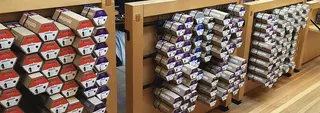
Digital overload, digital burnout, digital dementia, digital distraction—whatever you might call how social media and device notifications are changing the way we behave, if you’re constantly checking your phone, you’ve suffered its effects.
But the most recent development in digital overload isn’t its prevalence, but our growing understanding that it’s not simply fatiguing us—it’s preventing a productive work environment.
“We’re in an always-on culture, even when we think we have breaks,” says Holland Haiis, a digital detox and human connection expert. “Even when you’re out for a walk, we’re still on our devices. We’re in work mode at 7:30 at night in the grocery store, and our brains are never having any quiet time. That’s digital overload.”
The digital innovations that have us clicking our way through the day can lead to improving productivity in the workplace, but only to a point. In fact, productivity has plateaued: The business sector had a 2.1% productivity increase between 2019 and 2021—illustrating what’s known as the productivity paradox, or the idea that theoretical productivity gains from digital tools don’t translate into actual productivity.
“With digital overload, we go into a brain fog where it takes us longer to accomplish a task than it normally would have in the past—or more than it really should, because we’re strung out,” Haiis says. “It’s not that you can’t work on a project; it’s that you’re not at your best because your brain is overloaded. Our brain needs stillness.”
One way to cultivate that stillness and tune out distractions at work: paper. Workers are already flexing paper’s benefits—that productivity takes a variety of forms, including improved focus, time management and idea generation.
Digital tools can help us do everything from booking business travel to connecting with far-flung colleagues—and experts like Haiis aren’t suggesting that we try to eradicate that help within a productive work environment. “I love technology for the ease and simplicity that it gives to our lives, when we stay within the parameters of what we are using technology for,” Haiis says. But digitalization can’t replicate the human connection that drives workplace innovation.
Paper has the ability to deepen creativity and collaboration in meetings, a place where many workplaces misstep—senior managers say meetings are inefficient. As one of her ideas to improve productivity in the workplace, Haiis suggests that offices strive for device-free meetings: Participants come in with paper and write down their ideas for solving an issue, then circle their best idea and share with the group.
“That’s when you get things like, ‘Oh, I was thinking that too—let’s take that a little further,’” Haiis says. “Then someone else jumps in, and the next thing you know we’re building camaraderie, we’re building trust and we’re spending time together in a way that boosts everybody’s productivity and creativity. We’ve got all these brain chemicals exploding, and from there you’re increasing enthusiasm and excitement.”
More workplaces are beginning to reevaluate the tools that allow creativity to flourish and lead to a productive work environment. “Four or five years ago, people were resisting the idea of digital discipline,” Haiis says. “But now, ‘digital burnout’ is this term that we’ve accepted. We have the Mayo Clinic and other trusted advisers weighing in, which has opened corporate America’s neural pathways that maybe there’s something to this.”
If you're looking for more ways to be productive, take a look at these printable templates.



